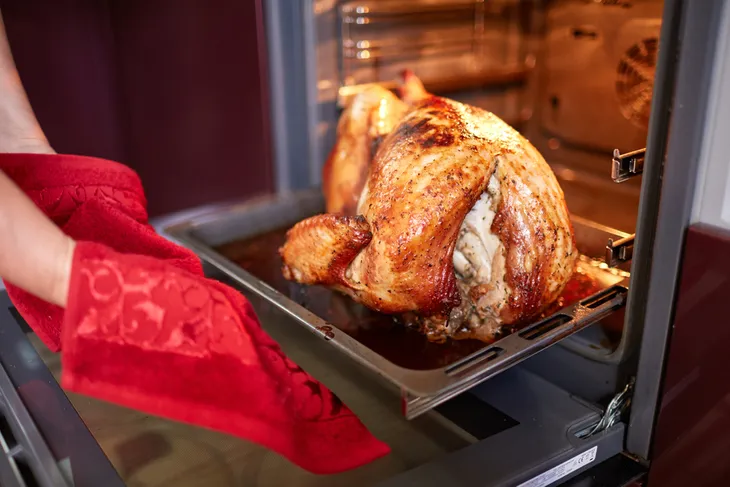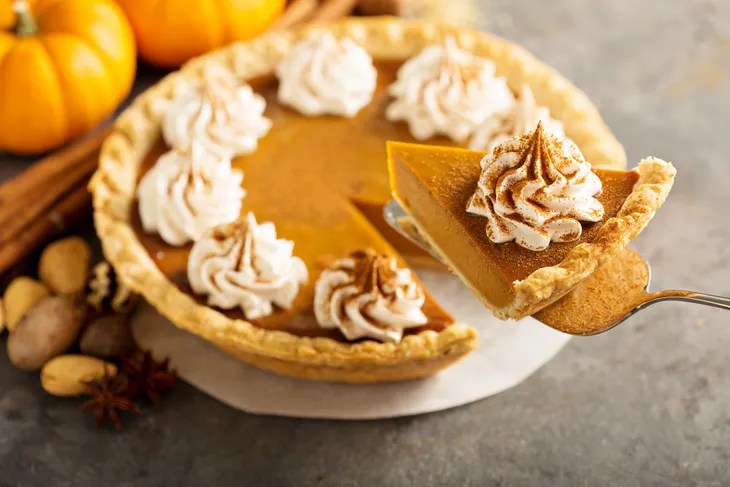- Many of our favorite Thanksgiving dishes are made with gluten: stuffing, gravy, pumpkin pie, and the list goes on.
- Thankfully, it is possible to still enjoy most of these dishes by making some gluten-free substitutes during the cooking and baking process.
- Make sure to inform hosts of your dietary restrictions, offer to bring a gluten-free dish, and don’t be shy when it comes to saying “no.”
Many families across America will be sitting down to enjoy a Thanksgiving meal with their family and friends. For some, this is their favorite holiday full of delicious, savoury dishes like gravy, stuffing, pumpkin pie, and of course, turkey! While there’s no denying these foods are tasty, they can also be full of gluten which poses a problem for those with a gluten allergy or intolerance.
Gluten can be a hard thing to avoid, but it’s not impossible. Many meals can now be made gluten-free with just a few simple swaps or substitutions. This means dietary restrictions don’t have to ruin another special holiday meal! Especially one that is traditionally packed with gluten-filled foods. Here are some tips on how to enjoy a gluten-free Thanksgiving dinner…
Avoid: Pre-Stuffed Turkey
The turkey is the heart of any Thanksgiving meal. While there are a select few who don’t like turkey, for the most part, you can expect every Thanksgiving table to have one of these juicy birds sitting at the center. People who cannot eat gluten might have to avoid this dish, but there is a way around it!
Instead of purchasing a pre-stuffed turkey, go for a fresh one whenever possible. According to the Canadian Celiac Association, pre-stuffed turkeys are usually contaminated with gluten which makes them unsafe to eat. This is particularly true for someone who is celiac or has another gluten disorder. It’s also important to note that some frozen turkeys are injected with broth to make them juicy, so the source also suggests avoiding these unless it can be determined that the broth is gluten-free.
Avoid: Gravy
Let’s face it, turkey without gravy is just not the same. It can be kinda dry without it which is why people love to douse their turkey in it. But unfortunately, people with a gluten allergy need to be wary of gravy because it’s often made from turkey drippings that are mixed in with wheat flour as a thickening agent.
Even the pre-packaged mixes of gravy often contain some hidden gluten, so either try to purchase special gluten-free ones or swap the gravy for cranberry sauce. You can also make a homemade gravy without gluten by swapping the flour out for sweet rice flour or cornstarch.
Avoid: Crusted Desserts
The first thing that comes to mind when we think of Thanksgiving desserts is pumpkin pie. There’s nothing better than finishing off a meal with a piece of warm pumpkin pie that has a nice flaky, crumbly crust that is topped with a big dollop of whipped cream. Yum! Sadly, this is another seasonal staple that should be avoided.
Most pumpkin pies are made with lots of flour and butter which is a no-go for people with a gluten allergy or intolerance. If you just can’t live without a slice, there are some gluten-free options on the market. Bob’s Red Mill makes a gluten-free pie crust, so does Pillsbury. Otherwise, swap it out for a dish of fruit and ice cream or another gluten-free treat.
Avoid: Green Bean Casserole
Unlike some of the other dishes on this list, this one might be surprising. But don’t be fooled by the vegetables. At first glance, it might seem harmless…green beans, milk, crispy onions, and a can of mushroom soup. What’s there to be scared of? Hiding behind all those green beans is lots of gluten.
When it comes to casseroles, you don’t have to avoid them entirely. It just depends what ingredients are used. If you’re going to serve up a helping of a green bean casserole, make sure you know all the ingredients first. For example, some cream of mushroom soups can contain wheat flour. Same with crispy onions. While it might not be obvious upfront, once the dish is broken down by ingredients it might reveal some hidden gluten.
Avoid: Stuffing
Personally, stuffing or dressing is my favorite part of a Thanksgiving meal. I’m not sure what it is about it, but it’s just so hearty, savoury, sometimes a little salty and delicious! Every cook does their stuffing a little differently by including or excluding little ingredients here and there, but there’s no avoiding that this dish is made mostly of doughy, floury bread.
This dish is someone with a gluten allergy or intolerance’s worst nightmare! While it can be made with gluten-free bread (or swap the bread out for cornbread), it’s best to just avoid this dish entirely. You’re safer loading up on some mashed potatoes or squash.
Avoid: Cornbread
Okay, we know that this one literally has bread in the title, but because it’s cornbread you might not think it actually contains gluten. Surprise! It’s actually a secret offender. Cornbread actually contains a mix of cornmeal and wheat flour, so similar to the stuffing, it’s got a lot of gluten in it.
You can still enjoy this dish by swapping out some of the ingredients and making a special gluten-free cornbread. Try purchasing a pre-packaged cornbread mix that is gluten free. Of course, for those who are adventurous it can also be made from scratch without gluten. The Food Network has a gluten-free cornbread recipe here.
Be Wary of Alcoholic Drinks
For some people, having a drink to break the ice is a necessity at family gatherings. While there’s no bread in sight, don’t assume a beverage can’t contain gluten. The biggest offender is beer. Most beer contains gluten, unless it states otherwise. There are many gluten-free beers out there, but don’t assume a host will have these on hand.
The Canadian Celiac Association suggests sticking to more safe options like wine, distilled alcohols, or gluten-free specific drinks. You can always ask to see the label before ordering or them pouring the drink.
Talk to Family and Friends
Don’t be shy about and dietary restrictions or skirt around the issue. Just be honest and upfront with family and friends. Chances are they want to listen and understand more about your condition, whether it’s an allergy or an intolerance. If they don’t know about it, they can’t help or be sensitive to it.
Also, don’t be shy about calling the host in advance to let them know. If they know ahead of time, they can ask questions about what is or isn’t gluten-free, make the proper adjustments or have alternatives available. This will help avoid any awkward conversations on Thanksgiving day at which point it’s too late to prepare an alternate dish. You can also offer to bring a gluten-free dish to help out.
Easy Gluten-Free Swaps
These days there are so many alternatives available, whether it’s vegan, dairy-free, or gluten-free. Now more than ever it’s easy to accommodate any dietary restrictions. You can easily make most Thanksgiving staples like gravy, stuffing, and even pie crust without gluten.
When it comes to the turkey, opt for a fresh, plain turkey. Avoid any that have added broth, spices, or pre-anything (i.e. pre-flavored, pre-stuffed, etc). Also, VeryWell Fit advises not opening any gravy package that comes with a turkey unless it specifically states that it is gluten-free. While it might be disappointing to pass on stuffing, it is possible to make this dish gluten-free. All it takes is using a gluten-free stuffing mix or simply…gluten-free bread. It’s truly that simple. Once all the spices are added, no one will notice the difference.
It’s also incredibly easy to make gluten-free gravy. VeryWell Fit suggests substituting the flour for cornstarch. Similar to the stuffing, you can also just purchase a gluten-free gravy mix. Lastly, another super easy swap is to purchase gluten-free dinner rolls. You can ask the host to pick them out or bring your own!
Prepare in Advance
We can’t always expect other people to be thinking of our dietary restrictions on the day of a big meal. While it’s hoped that they would offer some alternatives, it’s a good idea to also prepare in advance. In addition to calling ahead to talk about it with the host or restaurant, another option is to just bring a gluten-free dish. Chances are the host will greatly appreciate the help and it takes some extra work off their hands.
Let them know ahead of time that you’re bringing something so that they can plan accordingly, especially if it’s something that is going to require space in the oven or fridge. This way you’re not showing up empty handed, plus you know you’ll have something delicious to enjoy at dinner alongside everyone else.
Don’t be Afraid to Ask Questions
Depending on your relationship with the host and cook, it might be a little awkward, but it’s not worth jeopardizing your health or diet. Don’t be shy about asking questions, lots of questions. You can ask what ingredients they used to make the dish and even how it was prepared. Little things like dusting a pan with flour can make a big difference for someone who is gluten-free.
This might be something that has to be done each year as they may experiment with new dishes or recipes. One year they might have added soy sauce to the Brussel sprouts or a few bread crumbs to a casserole dish. The host might not realize that in addition to those obvious dishes like stuffing and pie, there’s a lot of hidden gluten in dishes that the average person just wouldn’t think of.
Say ‘No’
People with dietary restrictions or health conditions learn pretty fast they need to be their own advocates. In addition to asking lots of questions, sometimes this means learning to say ‘no.’ You don’t have to be rude about it, but kindly turn down any foods that are going to make you feel sick later in the evening.
Now is not the time to be a people pleaser. More often than not, it’s not going to hurt anyone’s feelings, especially if you’ve already informed everyone that you’re gluten-free and cannot eat certain foods. If you have to skip meals entirely, so be it. Show up after the meal is done so that you can still enjoy some quality time with friends and family.















